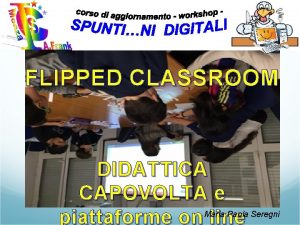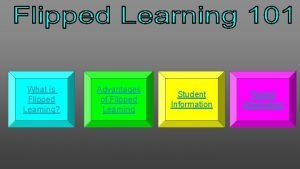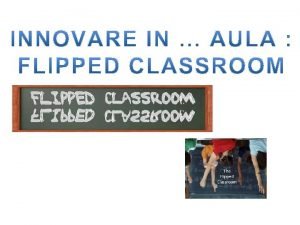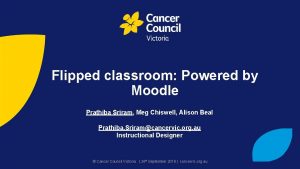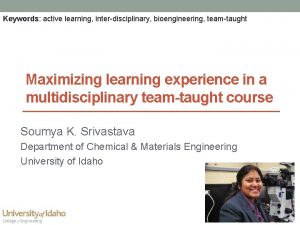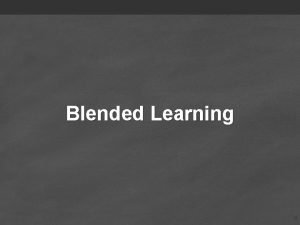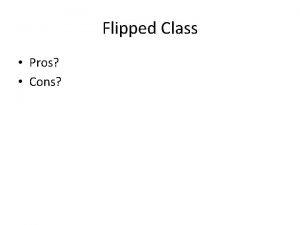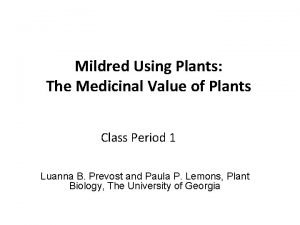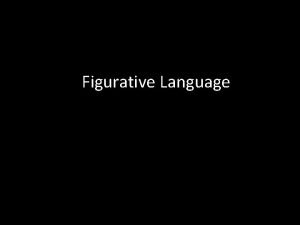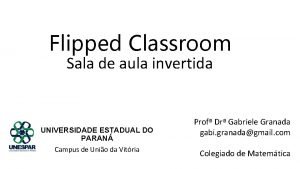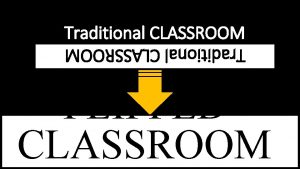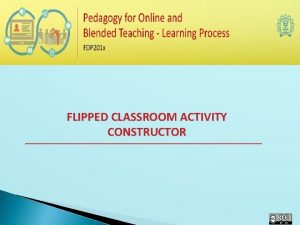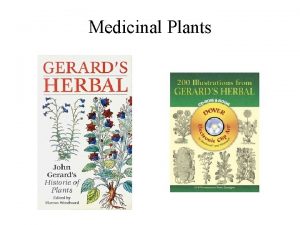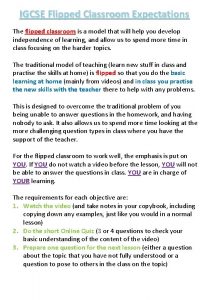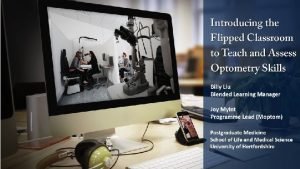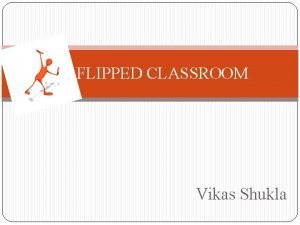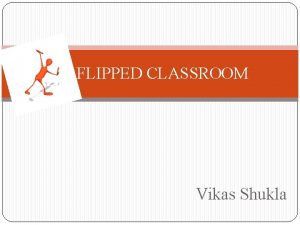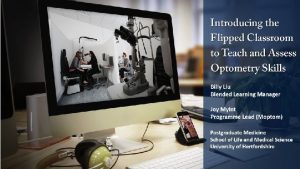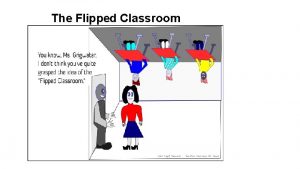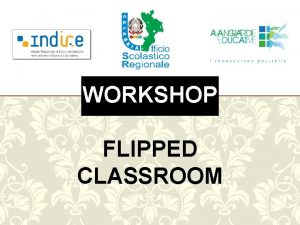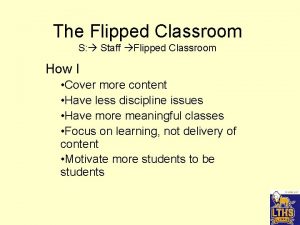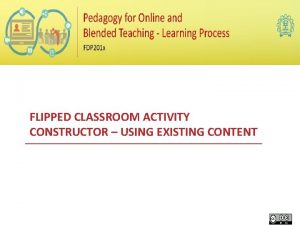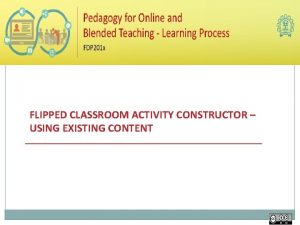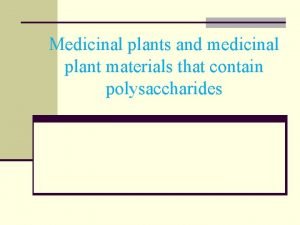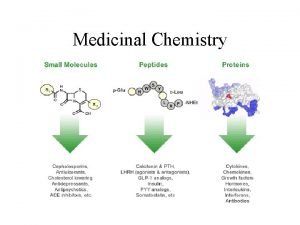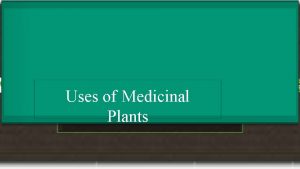FLIPPED CLASSROOM ACTIVITY Medicinal Plants for Human Welfare






















- Slides: 22

FLIPPED CLASSROOM ACTIVITY “Medicinal Plants for Human Welfare” IDP in Educational Technology, IIT Bombay

Table of Contents SECTION SLIDE ABOUT YOU 3 OUT-OF-CLASS SEGMENT 5 IN-CLASS SEGMENT 19 EVALUATION 32 COMMUNITY BUILDING IDP in Educational Technology, IIT Bombay 2

Dr. V N Shinde Introduction about me: Hello friends, my name is Dr. V N Shinde working as a Assistant Professor in the department of Botany at ADMSP’s, Arts and Science College, Mhasadi, Tal. Sakri Dist. Dhule (M. S. ). I am teaching Botany subjects at UG level for last few years. My area of specialisation is Mycology. But for this flipped classroom activity I choose a topic related to Medicinal Plants for Human welfare, an interdisciplinary topic which covers both biological and chemical aspects of phytochemistry. In this flipped classroom activity, I have plan to teach topic Medicinal Plants its uses. A main video of 10 min length is selected for out class segment. Student watch thie video, out class assignment is given to make it clear for what they will be assessed on and at what level. In class segment consist of active learning strategy with the help of Peer Instruction Strategy and Think pair share activity one after another. In peer instruction strategy students get feedback on their work, either from peers or you. While in think pair share activity higher order thinking has to expected by analyzing the various medicinal plants and their different uses for human welfare. At the last teacher collects the summery of out of class and in class activities and connects these summery with the help of students to understand the concepts. IDP in Educational Technology, IIT Bombay 3

Dr. V N Shinde Medicinal Plants for Human Welfare Medicinal Botany Under graduate students ADMSP’s, Arts and Science College, Mhasadi, Tal. Sakri Dist. Dhule (Maharashtra) IDP in Educational Technology, IIT Bombay 4

Out-of-class Activity Design -1 Learning Objective(s) of Out-of-Class Activity By the end of this section, you will be able to: ü Discuss the various major medicinal plants from India. ü Describe the diversity of medicinal plants from India ü Acknowledges the medicinal values of these plants. ü Describe the different uses of medicinal plants. ü Explain the process of diversity of medicinal plants and their value for human welfare • Students can identify the ancient folk remedy. • Students now aware the medicinal value and their uses for human welfare with its major phytochemicals. Key Concept(s) to be covered Major medicinal plants, medicinal value of these plants, Biological Molecules, uses of these plants, identification of medicinal plants, preparation of first aids at the time of emergency, importantly traditional knowledge become enlighten for future, identification of herbal medicine rather then allopathic medicine with side effect. IDP in Educational Technology, IIT Bombay 5

Out-of-class Activity Design - 2 Main Video Source URL: https: //youtu. be/gq. Mf_2 q 0 HWQ The video is consumed only 10 min which is good for flipping the classsroom. License of Video : Creative Commons Attribution-Share Alike 4. 0 International License. CC-BY-SA (reuse allowed) IDP in Educational Technology, IIT Bombay 6

Instructions to students for doing out of class activity Instructions 1. The original video is of 10 min length so it is advise you to watch the video atleast twice before coming to class. 2. After watching the video try to solve the given assignment/ question in slide 09. 3. If you unable to solve a particular question, watch the video again. For your convince each question and his answer related video segment information is provided in slide 06, this will help you in solving the assignment. 4. All the assignment are compulsory and you have to submit the assignment in written form before the 3 hours of in class segment. 5. Those student has successfully completed the assignment will get 05 marks which will be added in their internal marks. And it is also equivalent to one classroom attendance. 6. After completion of assignment try to write 250 words summary of your out class segment, what you learn from these video and also write down the points that you are unable to understand. IDP in Educational Technology, IIT Bombay 7

Out-of-class Activity Design - 2 Mapping Concept to Video Source CONCEPT VIDEO SEGMENT DURATION (in min) Introduction Importance of Medicinal Plants - 0: 00 – 0: 40 Biodiversity Area Species number and area 0: 41– 1: 52 Major Medicinal plants and their uses TOTAL DURATION 1: 11 1. Terminalia Chebula – 1: 53 – 3: 21 1: 68 2. Phyllantus emblica – 3: 22 – 5: 00 1: 78 3. Terminalia Belerica - 5: 01 – 5: 57 0: 56 4. Azardircta indica – 5: 58 – 7: 40 Provide total duration of video here** 5. Saraca indica – 7: 41 – 8: 47 1: 82 6. Garcenia indica - 8: 48 – 10: 14 1: 66 1: 06 Total video lenght = 10: 07 IDP in Educational Technology, IIT Bombay 8

Out-of-class Activity Design - 3 Aligning Assessment with Learning Objective Assessment Strategy Knowledge Q. 1 Answer in one line. Student will be 1) What are the medicinal plants? able to identify 2) Biodiversity area of medicinal plant in and India? acknowledge the 3) Enlist the number of major medicinal uses of medicinal plants from India? plants. Q. 2. Enlist the source of King of medicinal plant? Q 3. Enlist the uses of Behada plant? Expected Duration (in min) Additional Instructions (if any) 10 minutes Watch Initial part of video 08 minutes Watch middle part of video IDP in Educational Technology, IIT Bombay 9

Out-of-class Activity Design - 3 Aligning Assessment with Learning Objective Assessment Strategy Analysis Student now can Q 4. Give the example of both plants which compare have same medicinal property? different medicinal plant. Analysis Student can Q 5. Describe chemical content of Neem identify verious plant? phyto-drug present in medicinal plants Expected Duration (in min) Additional Instructions (if any) 04 minutes Watch middle part of video 04 minutes Watch end part of video IDP in Educational Technology, IIT Bombay 10

Out-of-class Activity Design - 3 Aligning Assessment with Learning Objective Assessment Strategy Comprehension Students can describe the Q 6. Explain the rare secondary metabolites various from major medicinal plants? uses of medicinal plants as folk remedy. Expected Duration (in min) Additional Instructions (if any) 04 minutes Watch full video Total activity duration = 30 min IDP in Educational Technology, IIT Bombay 11

In-class Activity Design -1 Learning Objective(s) of In - Class Activity At the end of the In-class activity, students will be able to, 1. Student will able to explain major types of medicinal plants. 2. Student also able how the uses of medicinal plants as folk remedy. 3. Student will understand the composition present medicine and their relationship with phytochemcial. 4. Student will be able to classify the major and minor medicinal plants. 5. Students will able to uses these medicinal remedy as herbal medicine. 6. Student will able to explain the various types of chemical constitute of medicinal plants. 7. Student can identify surrounding medicinal plants. Key Concept(s) to be covered 1. 2. 3. Uses of herbal medicine. Identification of phytodurg. Formation of new herbal medicine to avoid side effect. IDP in Educational Technology, IIT Bombay 12

In-class Activity Design -2 Active Learning activity(ies) that you plan to do 1. Peer instructions Explain the strategy by giving details of 1. What Teacher will do? Pose some PI questions at the start of the class and provide summary of basic information and simplification. 1. What Student will do? student will divided into groups of three to four peers and where they discuss, try to understand each justification and come to final solution 2. What Teacher will do? teacher now tell one of the peer group to share its discussion, then teacher will take some follow up question and try to find out the correct solution with the help of all student present in the classroom. 2. What Student will do? student take active participation in the discussion while teacher asks follow up questions, they put their view again if there are some mistake with the help of teacher they get back to correct solution. IDP in Educational Technology, IIT Bombay 13

In-class Activity Design -2 Active Learning activity(ies) that you plan to do 1. Peer instructions- continues…. . Justify why the above is an active learning strategy 1. First of all student are already learn some basics by watching the videos provided by the teacher. When teacher poses peer instruction question they form the groups and share what they learn by watching the videos. Obliviously all students are not watch the whole video seriously but when they works In peer they exchange the content what they see or understand. Also on the same topic they may have different view but in group they have to provide the justifiable solution, where the actually they recall and link their knowledge in the form of concepts and information. 2. Secondly when teacher some group solution in front of all they again think what the new things are come in the solutions, whether they are correct or incorrect they try to compare their answer with the solution of other. 3. Finally when teacher come to the final solution they realize what was the actual concept, what they actually thinks, what correct and what incorrect and where they have to improve their knowledge or thinking direction. IDP in Educational Technology, IIT Bombay 14

In-class Activity Design -2 Actual peer instruction strategy for the given topic- protein and its structure. Peer Instruction Strategy – What Teacher Does Pose some PI questions at the start of the class and provide summary of basic information and simplification. Q 1. How to isolate the phytochemicals from medicinal plants? • what are the methods of the primary isolation? • What are advance methods of isolation of photochemical? • What is the impact of uses of herbal medicine for human welfare? Q 2. what will standards to use medicinal plants for human welfare? • Name the different methods of uses? • Which medicinal plant is useful for the problems regarding the urination? IDP in Educational Technology, IIT Bombay 15

In-class Activity Design -2 TPS Strategy – What Instructor does for the given topic- Protein Instructor asked a question for all class as What are the benefits of Amla for human welfare? In think phase each student individually think what will happen after the appropriate use Amla plant. What is effect of Amala plants after consumption internally and external use. This activity will take 5 minutes. In pair phase, student will discuss with its neighboring peer member exchange its idea with peers. They share their views on, what are the possible effect of Amala plants after consumption internally and external use. During this pair phase instructor gives some hint questions about uses of Amala. This activity will take 5 minutes. IDP in Educational Technology, IIT Bombay 16

In-class Activity Design -2 TPS Strategy continues --In share phase, teacher ask one on the peer group member to come on the front of the whole class room and share their discussion on the topic. While they share their discussion student asks some frequent question to the student which will bring the student towards the right answer of the question. If student have some difficulties with the solution that come finally they asks the teacher, and teacher will give answer with the help of students. This will take another 10 minutes. IDP in Educational Technology, IIT Bombay 17

In-class Activity Design -2 Justify why the above is an active learning strategy In both the above strategies, students are required to go beyond mere listening and execution of prescribed steps. They are required to think deeply about the content they were familiarized in out-of-class and do higher order thinking. There is also feedback provided (either through peer discussion or instructor summary) IDP in Educational Technology, IIT Bombay 18

In-class Activity Design -2 Summary At the end of In class activity instructor summarise both out class activities and In class activity summery from the information that collected during the both process. Instructor also provide the more details and correct information related to the topics. Instructor provide summary that connects Out-of-Class and In-Class activities. IDP in Educational Technology, IIT Bombay 19

In-class Activity Design -2 Evaluations Instructor set a assignment at the end of the class which consist of ten multiple choice questions, which check whether the learning objectives of the topics are achieved or not or at what level the objectives are achieved. The details of the multiple choice questioners is at the following linkhttps: //drive. google. com/open? id=0 B 3 dmf. IPye. E 6 o. Vm. Z 2 ZEM 4 e. TRBa 1 U IDP in Educational Technology, IIT Bombay 20

In-class Activity Design -2 feedback Feed back form: Finally I given link of the feed back form which student have to fill, and instructor will evaluate whether the learning objectives are achieved or not or what level they achieve. It also help instructor to design the future such flipped classroom activity. The details of the feedback form is available at the following linkhttps: //goo. gl/forms/YE 7 g. H 2 x. Cl. D 3 w. DDgq 2 IDP in Educational Technology, IIT Bombay 21

Thank you. IDP in Educational Technology, IIT Bombay 22
 Cosa prevede “inquiry flipped classroom”:
Cosa prevede “inquiry flipped classroom”: Flipped learning advantages and disadvantages
Flipped learning advantages and disadvantages Venitemi dietro con l'occhio
Venitemi dietro con l'occhio Meg moodle
Meg moodle Flipped classroom schema
Flipped classroom schema Bioengineering flipped classroom
Bioengineering flipped classroom Flipped classroom
Flipped classroom Flipped classroom model
Flipped classroom model Flipped classroom pros and cons
Flipped classroom pros and cons Objectives of medicinal plants
Objectives of medicinal plants Medicinal horticulture definition
Medicinal horticulture definition Btech smart classes
Btech smart classes Microbes in human welfare
Microbes in human welfare Microbes in human welfare
Microbes in human welfare Flipped book setting
Flipped book setting Flipped advising
Flipped advising Language
Language Flipped math calculus
Flipped math calculus Flipped sum of its parts
Flipped sum of its parts Classroom
Classroom Flipped
Flipped Vascular plants
Vascular plants Nonvascular plants reproduction
Nonvascular plants reproduction
